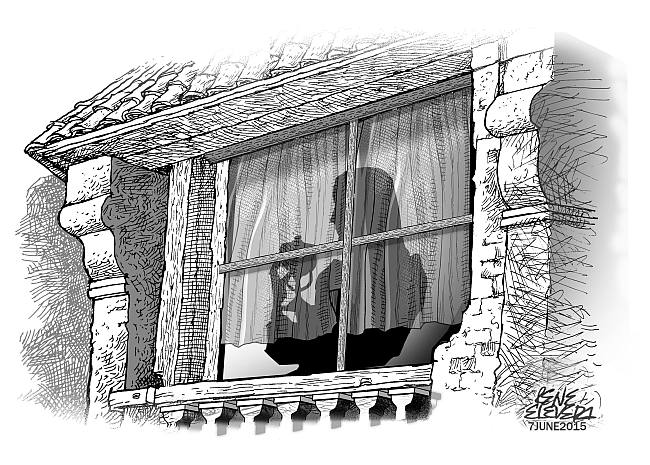Three years ago, we visited the city of Santarém in Portugal. We left Fatima, our base, in the morning and spent a few hours at the nearby hamlet of Aljustrel, to visit the homes of the three children who saw the Blessed Virgin Mary in a series of apparitions in 1917. After that we traveled by bus to Santarém, arriving there within one hour.
Pedro Álvarez Cabral, who discovered Brazil, resided in Santarém, a fact in which the city takes pride. But perhaps more than this, the city boasts of the Church of the Holy Miracle which since the 13th century has housed a consecrated host that miraculously bled in the hands of a woman who had filched it for a blasphemous purpose.
While waiting for our turn to enter the church, our group stayed at a little plaza just outside the shrine, picking the fruit of the olive trees that grew there. I took pictures of the surroundings. I noticed a woman standing by the window of a room on the upper floor of a building not far from the church. Apparently, she kept an eye on us, perhaps wondering about our group – Asians fully bundled against the autumn chill, another group of pilgrims visiting the shrine from the far reaches of the globe. She wore a red blouse. Her build put her at middle age. I surprised her by taking her picture.
Upper rooms fascinate me. They tell me many things – stories that happen in the twilight zone between the public and private realms. What kind of life did that woman and her family live? She probably had a husband and children, and at that time of day they might just have finished a light meal, probably of tea, sandwiches and cake.
I realized that I should not peer into their lives beyond watching whatever appeared on the window, the only concession those who lived there could make to the outside world, which at any time they could shut out by closing the window or drawing in the drapes or louver, or just by staying out of sight.
Our turn came to view the miraculous host. We piled into the back of the altar and one by one went up a metal ladder to look at the monstrance and its content. There inside a glass pyx I saw the host. Time had turned the bread into a crystal-like wafer. A reddish liquid, blood, had settled at the bottom of the pyx.
In the early 13th century, a woman had sought the help of a sorceress concerning a philandering husband. The sorceress promised to cure her husband’s infidelity in exchange for a consecrated host. The woman agreed, and at Mass, after she received Holy Communion, she took out the host from her mouth and wrapped it with her veil. But the host began to bleed, so much that the people in the church thought that she had cut her hand. She rushed home and threw the host inside a trunk in their bedroom.
That night a mysterious light emitting from the trunk woke her and her husband up, prompting the woman to tell the latter what she had done. The next morning, the couple reported the matter to the parish priest, who came and took the host back to the church in a wax container. Miraculously, the next time the priest inspected the host, he saw its wax container broken into pieces and the host already enclosed in a crystal pyx.
After an investigation, the Catholic Church gave credit to the miracle, which in no time became so widely known that St. Francis Xavier himself visited the shrine and prayed before the host prior to setting off for his missionary work in India.
Incidentally, I saw a connection between the woman at the window of a room on the upper story of the building and the miraculous host, and not just because she wore a blood-red blouse. I recalled that Christ instituted the Eucharist likewise in an upper room, in which he and his apostles had their Passover meal, in the course of which he blessed the bread, saying, “This is my body,” and the wine, saying, “This is my blood.” Every time the priest enunciates these words – the words of consecration – the host and the wine, through a process called transubstantiation, turns into the body and blood of Christ.
Every upper room reminds me of the Mass. Although I do not see the Lord, I believe in his presence in the Eucharist – the window of the upper room, through which he looks at me, albeit hidden behind the curtain of the host.
Disclaimer: The comments uploaded on this site do not necessarily represent or reflect the views of management and owner of Cebudailynews. We reserve the right to exclude comments that we deem to be inconsistent with our editorial standards.

